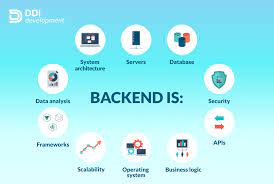Top Backend Technologies For Your Project: pros & cons [2023]
Backend technologies form the foundational framework of any digital project, providing the infrastructure that supports its functionality. In 2023, several key backend technologies have emerged as frontrunners, each offering distinct advantages and drawbacks. This log explores these technologies passively, analyzing their pros and cons to aid in informed decision-making for upcoming projects.
1. Node.js
Node.js has gained prominence for its event-driven architecture and non-blocking I/O operations. It is widely used for building scalable network applications, particularly in real-time web applications. JavaScript, being its primary language, allows for seamless frontend-backend integration.
Pros: Node.js excels in handling concurrent requests with high efficiency, making it ideal for applications requiring speed and responsiveness. Its large package ecosystem through npm simplifies integration of additional functionalities. Moreover, its asynchronous nature enhances performance by minimizing downtime and latency issues.
Cons: However, Node.js faces criticism for its callback-based coding style, which can lead to callback hell and complex code management. Scalability can also be challenging, requiring careful architecture design to manage increasing loads effectively.
2. Django
Django, a Python-based framework, is renowned for its simplicity and rapid development capabilities. It follows the MVC (Model-View-Controller) pattern and emphasizes DRY (Don’t Repeat Yourself) principles, promoting efficient and maintainable code.
Pros: Django offers robust built-in security features, such as protection against SQL injection, CSRF (Cross-Site Request Forgery), and clickjacking. Its extensive documentation and vibrant community support ensure developers have ample resources for troubleshooting and enhancement. Furthermore, Django’s ORM (Object-Relational Mapping) simplifies database interactions, reducing the need for manual SQL queries.
Cons: Despite its advantages, Django’s rigid structure may limit flexibility in some complex projects. Its reliance on synchronous processing can occasionally impact performance, particularly in scenarios requiring real-time data processing or heavy concurrent tasks.
3. Ruby on Rails
Ruby on Rails, often referred to simply as Rails, is a full-stack web framework known for its convention over configuration principle. It emphasizes developer productivity by favoring sensible defaults and minimizing configuration requirements.
Pros: Rails excels in rapid prototyping and development thanks to its integrated tools and predefined conventions. It offers a vast ecosystem of plugins (Gems) that extend its functionality significantly. Additionally, Rails’ strong community support and extensive libraries enhance its appeal for startups and small to medium-sized projects.
Cons: However, Rails’ adherence to its conventions can lead to constraints for developers seeking unconventional solutions. Performance can also be a concern for high-traffic applications, as Rails’ monolithic architecture may struggle with scalability compared to more modular frameworks.
4. ASP.NET Core
ASP.NET Core, developed by Microsoft, is a cross-platform, open-source framework for building modern, cloud-based applications. It supports multiple programming languages, including C#, F#, and Visual Basic, offering flexibility and compatibility.
Pros: ASP.NET Core excels in performance and scalability, leveraging asynchronous programming patterns and multi-threading capabilities. Its integration with Microsoft Azure provides seamless cloud deployment options, enhancing scalability and reliability. Furthermore, ASP.NET Core’s strong typing and extensive libraries simplify development tasks and improve code maintainability.
Cons: Despite its advantages, ASP.NET Core’s learning curve can be steep for developers unfamiliar with Microsoft’s ecosystem. Its reliance on Windows for some advanced features and tools may limit deployment flexibility in non-Windows environments.
5. Express.js
Express.js, a minimalist Node.js framework, is widely favored for building lightweight and fast web applications and APIs. It provides essential web application features without imposing excessive structure or complexity.
Pros: Express.js offers unparalleled flexibility and customization options, allowing developers to tailor applications precisely to their needs. Its middleware-based architecture simplifies adding additional functionalities and integrating third-party modules. Moreover, Express.js’ lightweight nature ensures minimal overhead, making it suitable for microservices and small-scale projects.
Cons: However, Express.js’ minimalist approach can sometimes require additional configuration and setup compared to more opinionated frameworks. It may lack built-in solutions for certain complex functionalities, necessitating reliance on external libraries or custom development.
Conclusion
In conclusion, choosing the right backend technology for a project involves careful consideration of its specific requirements, scalability needs, and developer expertise. Each technology discussed—Node.js, Django, Ruby on Rails, ASP.NET Core, and Express.js—offers unique strengths and challenges. Node.js excels in high-performance, real-time applications; Django prioritizes security and maintainability; Ruby on Rails emphasizes rapid development; ASP.NET Core combines performance with cross-platform compatibility, and Express.js provides flexibility and lightweight efficiency.
By evaluating these technologies passively based on their pros and cons, project stakeholders can make informed decisions that align with their project goals and development capabilities. As technology evolves, so too will the landscape of backend frameworks, offering new opportunities and challenges for developers and businesses alike.










